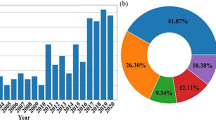Abstract
In this paper, we will introduce composite finite elements for solving elliptic boundary value problems with discontinuous coefficients. The focus is on problems where the geometry of the interfaces between the smooth regions of the coefficients is very complicated.
On the other hand, efficient numerical methods such as, e.g., multigrid methods, wavelets, extrapolation, are based on a multi-scale discretization of the problem. In standard finite element methods, the grids have to resolve the structure of the discontinuous coefficients. Thus, straightforward coarse scale discretizations of problems with complicated coefficient jumps are not obvious.
In this paper, we define composite finite elements for problems with discontinuous coefficients. These finite elements allow the coarsening of finite element spaces independently of the structure of the discontinuous coefficients. Thus, the multigrid method can be applied to solve the linear system on the fine scale.
We focus on the construction of the composite finite elements and the efficient, hierarchical realization of the intergrid transfer operators. Finally, we present some numerical results for the multigrid method based on the composite finite elements (CFE–MG).
Similar content being viewed by others
References
I. Babuška (1970) ArticleTitleThe finite element method for elliptic equations with discontinuous coefficients Computing 5 207–213
I. Babuška B. Andersson P. J. Smith K. Levin (1999) ArticleTitleDamage analysis of fiber composites. I Statistical analysis of fiber scale Comput. Meth. Appl. Mech. Engng. 172 27–77
I. Babuška G. Caloz J. E. Osborn (1994) ArticleTitleSpecial finite element methods for a class of second-order elliptic problems with rough coefficients SIAM J. Numer. Anal. 31 IssueID4 945–981 Occurrence Handle95g:65146
I. Babuška J. E. Osborn (2000) ArticleTitleCan a finite element method perform arbitrarily badly? Math. Comp. 69 IssueID230 443–462 Occurrence Handle2000i:65114
P. G Ciarlet (1987) The finite element method for elliptic problems North-Holland Amsterdam
D. Cioranescu J. Saint Jean Paulin (1999) Homogenization of reticulated structures Springer New York
Frauböse, N., Sauter, S.: Composite finite elements and multigrid. Part I: Convergence theory in 1-d. Proc. 17th GAMM-Seminar Leipzig on Construction of Grid Generation Algorithms, MPI Leipzig, 2001
W. Hackbusch (1985) Multi-grid methods and applications Springer Berlin Heidelberg
W. Hackbusch S. A. Sauter (1996) ArticleTitleAdaptive composite finite elements for the solution of PDEs containing nonuniformly distributed micro-scales Mater. Model 8 31–43 Occurrence Handle1444870
W. Hackbusch S. A. Sauter (1997) ArticleTitleComposite finite elements for the approximation of PDEs on domains with complicated micro-structures Numer. Math. 75 IssueID4 447–472 Occurrence Handle10.1007/s002110050248 Occurrence Handle97k:65251
W. Hackbusch S. A. Sauter (1997) ArticleTitleComposite finite elements for problems containing small geometric details. Part II Implementation and numerical results Comput. Visual Sci. 1 15–25 Occurrence Handle10.1007/s007910050002
W. Hackbusch S. A. Sauter (1998) ArticleTitleNew finite element approach for problems containing small geometric details Arch. Math. 34 IssueID1 105–117 Occurrence Handle99e:65156
T. Hou X.-H. Wu (1997) ArticleTitleA multiscale finite element method for elliptic problems in composite materials and porous media J. Comput. Phys. 134 IssueID1 169–189 Occurrence Handle10.1006/jcph.1997.5682 Occurrence Handle98e:73132
V. V. Jikov S. M. Kozlov O. A. Oleinik (1994) Homogenization of differential operators and integral functionals Springer Berlin Heidelberg
A. M. Matache I. Babuška C. Schwab (2000) ArticleTitleGeneralized p-FEM in homogenization Numer. Math. 86 IssueID2 319–375 Occurrence Handle2001f:65139
N. Neuss W. Jäger G. Wittum (2001) ArticleTitleHomogenization and multigrid Computing 66 IssueID1 1–26 Occurrence Handle10.1007/s006070170036 Occurrence Handle2002a:65196
J. M. Melenk I. Babuška (1996) ArticleTitleThe partition of unity finite element method: basic theory and applications Comput. Meth. Appl. Mech. Engng. 139 IssueID1–4 289–314
O. Oleinik A. Shamaev G. Yosifian (1992) Mathematical problems in elasticity and homogenization Amsterdam North-Holland
S. A. Sauter (1997) Vergröberung von Finite-Elemente-Räumen Christian-Albrechts-Universität zu Kiel Habilitationsschrift
S. A. Sauter R. Warnke (1999) ArticleTitleExtension operators and approximation on domains containing small geometric details East-West J. Numer. Math. 7 IssueID1 61–77 Occurrence Handle2000c:65105
R. Warnke (2003) Schnelle Löser für elliptische Randwertprobleme mit springenden Koeffizienten Universität Zürich Diss. thesis
Author information
Authors and Affiliations
Corresponding author
Rights and permissions
About this article
Cite this article
Sauter, S.A., Warnke, R. Composite Finite Elements for Elliptic Boundary Value Problems with Discontinuous Coefficients. Computing 77, 29–55 (2006). https://doi.org/10.1007/s00607-005-0150-2
Received:
Revised:
Published:
Issue Date:
DOI: https://doi.org/10.1007/s00607-005-0150-2




